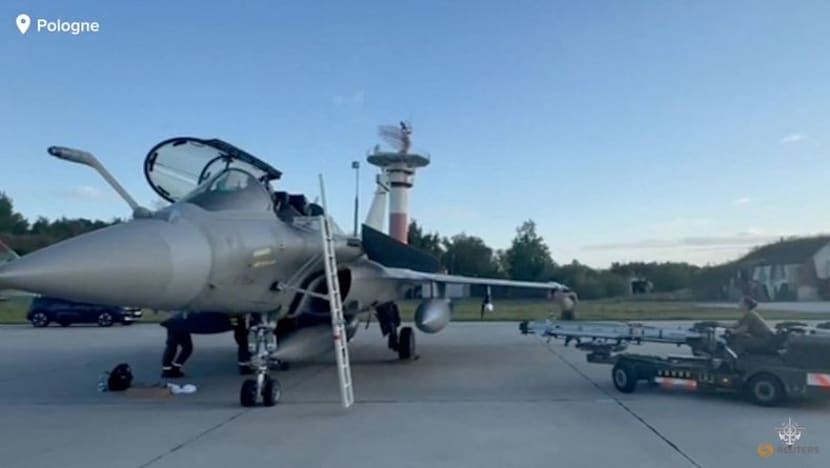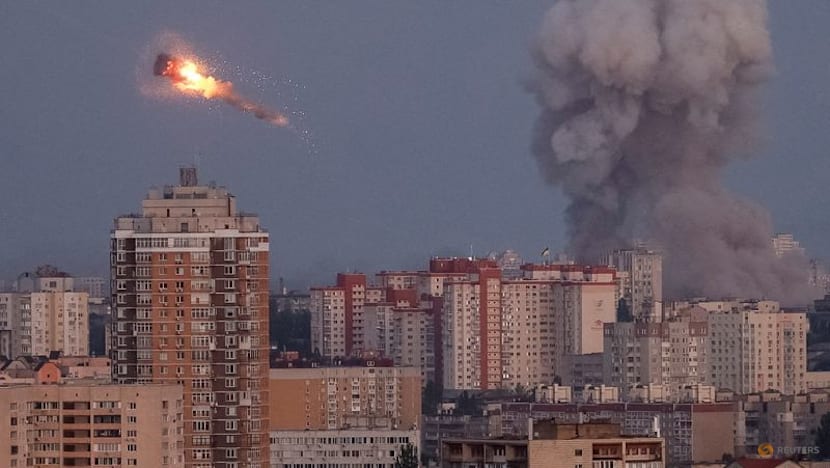Commentary: How a no-fly zone could save Ukraine
Russia’s brazen drone incursions into Poland and Romania demand a NATO response in the skies, says James Stavridis for Bloomberg Opinion.

WASHINGTON: For more than three years, Ukrainian President Volodymyr Zelenskyy has been desperately pleading for Western allies to “close the skies” over his nation. The Russians have launched wave after wave of increasingly capable drones, manned bombers and cruise missiles, including the hypersonic Iskander that hit the government’s headquarters in Kyiv last week.
The Kremlin has long drawn on its playbook from past wars in Chechnya and Syria: brutal bombing campaigns that do not discriminate between legitimate military targets and civilian population centres. President Vladimir Putin’s objective is to break the will of the Ukrainians. Despite his brutal tactics, the North Atlantic Treaty Organization (NATO) has refused to establish a no-fly zone over Ukraine.
The reason for this reticence is simple: fear of escalation to direct combat between Russian and NATO forces. A no-fly zone would require NATO jets to patrol over Ukrainian territory.
Keeping those manned aircraft safe could even require neutralising advanced Russian S-400 anti-aircraft sites in both Russia and Belarus. It would probably require rules of engagement that permit NATO fighters to shoot down not only Russian drones and missiles, but also the Kremlin’s manned bombers and fighters.
RUSSIAN DRONE INCURSION SHIFTED THE CALCULUS
The concern throughout the war has been that such direct NATO-Russian combat could lead to broader warfare on the ground and in the waters of the Black Sea, along with broader cyberattacks against Western nations by Moscow.
At the dark end of the spectrum, of course, would be a tactical nuclear strike – a threat that Putin and his lieutenants often make. It is understandable that NATO has drawn the line at providing increasingly lethal weapons to the Ukrainians and putting diplomatic and economic pressure on Moscow.
But starting last week, that calculus may have changed, with a significant incursion of Russian drones into NATO member Poland. Does that intrusion, which was the subject of an intensive Article 4 consultations at NATO headquarters in Brussels, constitute a tipping point? (Article 4 is triggered when a member state believes its territorial integrity or political independence is threatened.)
NATO secretary general Mark Rutte said what happened in Poland was not an “isolated incident”. Indeed, Romanian authorities allege that a similar incursion happened in their airspace on Saturday (Sep 13). On Monday, Poland’s foreign minister said NATO allies should be empowered to shoot down “drones and other flying objects” over Ukrainian territory.
SHOULD NATO ESTABLISH A FULL NO-FLY ZONE?
Given all this, should NATO now establish a full no-fly zone? And what other options can we consider to pressure Moscow to back down?
During my tenure as supreme allied commander of NATO, I spent quite a bit of time at the massive Ramstein Air Base in southwest Germany, home to more than 15,000 US troops. It is the HQ for all US air operations in Europe and Africa, and the centre for all NATO air operations globally.
NATO has its own complete airwing of more than a dozen E-3 Airborne Early Warning Aircraft (AWACS), sufficient to maintain 24/7 visibility over Ukrainian airspace and NATO’s eastern border. The alliance’s newly announced Operation Eastern Sentry – an initiative to reinforce its eastern flank – will include US Air Force F-35 Lightning combat jets, the most cutting-edge fifth-generation fighters in the world.
Additionally, advanced combat aircraft from Poland, the UK, France and the Baltic nations – including Swedish JAS 39 Gripens, French Dassault Rafales and Eurofighter Typhoons – will participate.
I remember leading joint air-warfare exercises more than a decade ago and marvelling at the seamless command and control flowing from Ramstein up to the AWACS and then to the fighters on frontline. NATO is very, very good at these kinds of high-tech operations.

THE TIME HAS ARRIVED
The question is whether we have reached the point of shifting Operation Eastern Sentry into place over Ukraine. Doing so could be part of a combination of new measures that have been on table for months, awaiting decisions from Washington and Brussels.
President Donald Trump over the weekend signalled a readiness to impose severe secondary sanctions on nations trading with Moscow, and strongly urged the Europeans stop buying any Russian oil and gas, which they should. It is high time to confiscate the US$300 billion in Russian “frozen assets” largely in European financial institutions.
And giving the Ukrainians even longer-range missiles and drones – along with targeting technology – to go after Russian drone production, storage, maintenance and operational centres makes sense.
Let’s face it: A no-fly zone is a very aggressive move, and it carries real risk of further escalation. But given Putin’s recklessness, ruthlessness and intransigence – most clearly demonstrated by his ignoring Trump’s personal efforts at diplomacy – we have arrived at the time to close the skies over Ukraine.
In concert with other economic and diplomatic tools, it may be the only way to convince Moscow that its attempts to conquer all of Ukraine will prove futile.














